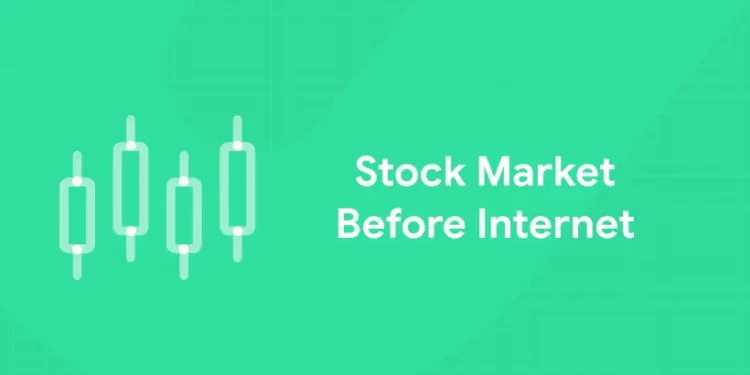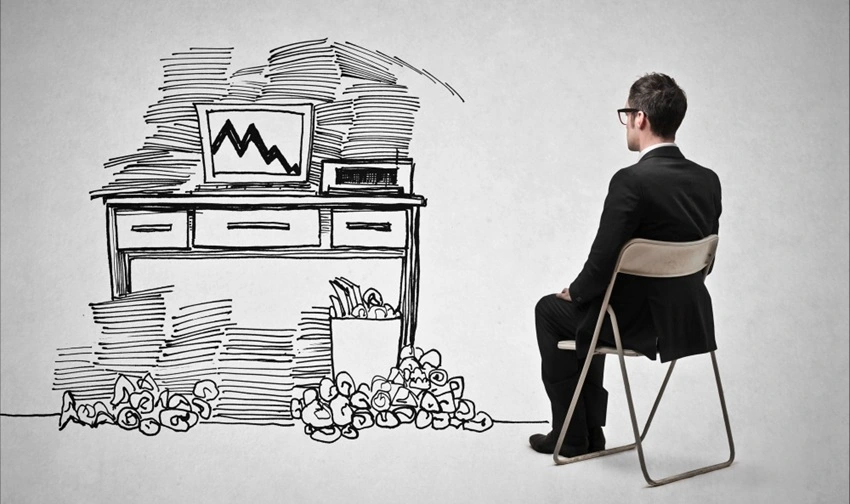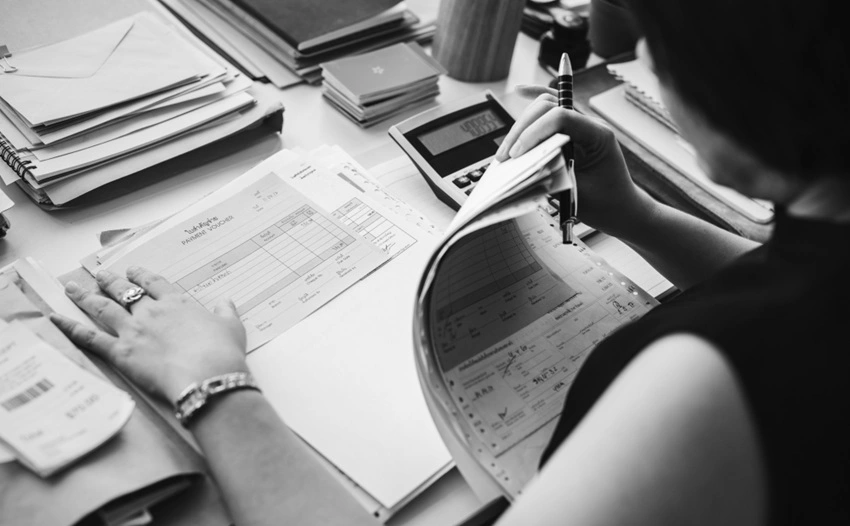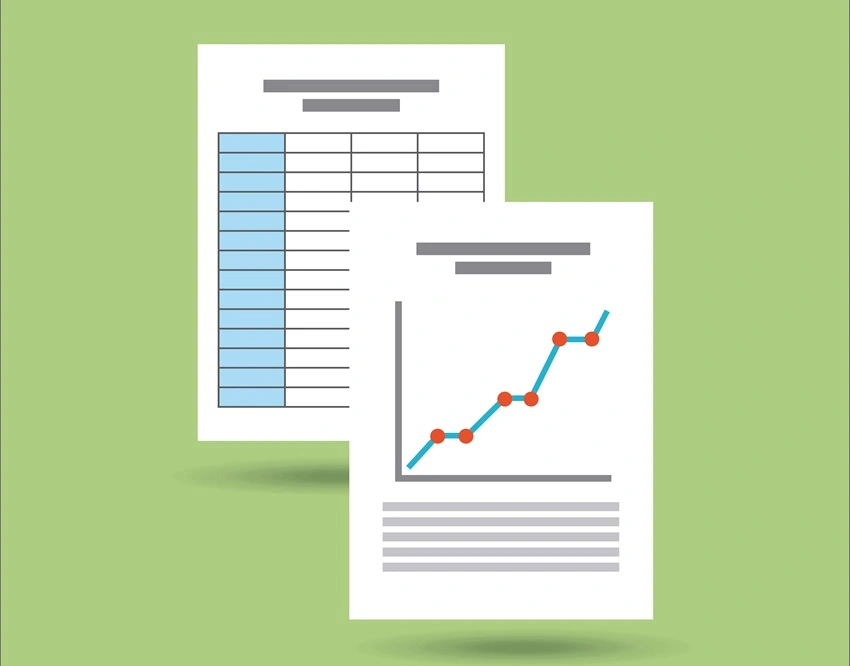Table of Contents
When you think of the stock market today you probably picture all sorts of stuff – bright computer screens, those rolling tickers you see on TV, mobile apps that let you trade on the go & notifications popping up on your phone. Buy & sell orders can get executed in a fraction of a second, news travels the globe in what feels like an instant, and even complete beginners can start investing with just a couple of taps on their smartphone.
But before the internet came along & completely upended the way we do things, the stock market looked like an entirely different animal altogether.
There were no online brokerages to speak of, no fancy charts to analyse, no instant data feeds to keep you in the loop. Investors relied on paper newspapers, handwritten accounts, landlines & the good old floor trading chaos to try & make sense of it all. Every trade required hard work, patience & having a decent network of brokers on speed dial – no automated systems, no high-speed computers running algorithms, & you definitely needed a demat account before you could even think about putting your money down.
To be honest, the pre-Internet stock market was a more laid-back affair, more human & much more people-oriented. Relationships mattered, instinct & hunches played a much bigger role.
This blog is a trip down memory lane, taking you back in time to see just how the stock market worked before the internet. Whether you’re looking to make a career out of finance or just want to get a better understanding of how it all came to be, this is your guide to the early days of investing & why it all matters.
Want to learn stock trading? Click here to watch the Entri stock market course demo classes!
Stock Market Before the Internet
Before computers took over the stock market, you needed three things to become a skilled stock trader. Initially, it would have been necessary for you to have an office capable of creating charts. Secondly, your company would need to be connected to the exchange by phone. Third, someone loud and aggressive enough to give orders using the open outcry approach would need to work for your company.
But do you know how to use the stock market in this present age where everything is digitalised and computerised? Do you know the basic principles that form the foundation of the workings of the stock market? If not. There is no need to worry! Entri is providing a stock market online course that can teach you all about the stock market and trading from scratch. They have experienced mentors, daily market analysis, live sessions, practical trading support etc. Learn stock trading at your own pace in the comfort of your own home. No hefty fees, no lengthy commute.
The Era of Hand-Drawn Graphs and Stock Ticker Tape
We are accustomed to computer-drawn graphs nowadays. These graphics enable quick trade transmission and are automatically updated with the most recent data. We take for granted the subtle art of hand-drawn stock graphs, and everything happens with ease. Every price adjustment made on an exchange before the 1960s required documentation. You had to record the moment and price increase when a stock increased by one dollar. You may eventually develop a stock chart that you could use as a guide for trading.
All stock market data was sent over telegraph lines between 1870 and 1960. Subsequently, a machine would receive this telegraph message and output the most recent stock data on volume and price. This invention was known as ticker tape, and it served as the informational foundation for all professional traders. Individuals skilled at creating precise graphs from these ticker tapes would be employed by reputable trading companies. These individuals would graph and show charts to management for the day, after which they would place trade orders. William Peter Hamilton, one of the pioneers of technical analysis, wrote a whole book in 1897 about the idea and subtleties of investing with a focus on graphs.
To send precise financial data on stock exchanges, stock tickers would eventually be replaced by rudimentary computers in the 1960s. The volume and the most recent pricing were the only things these incredibly outdated computers could display.
Professional Stock Graph Drawers
Professional stock graph drawers were in existence until businesses began using computers to automate their work in the late 1970s. Hand-creating graphs from stock ticker tape significantly slowed down the trading lifestyle, as you might expect. We can make trades instantly these days. Drawing out a graph and making a judgment would take an hour before the invention of computers in trading.
Click here to learn more about the best stock market online course offered by the Entri app!
Telephones
A well-established trading company has decided to execute a deal. They would now have to send that information back to the exchange so that a representative of that company could place the stock trade.
To trade a specific stock at the market before 1878, your trading company would have needed to send a runner to deliver the message. Fast stock runners received excellent compensation, but this required significant time. In actuality, the main factor influencing stock prices in the 19th century was public information dissemination.
The first telephone was put on the New York Stock Exchange in 1878, making it a significant year. The stock market was transformed by the telephone. Businesses could now forecast by reading the ticker tape, and then call the floor to execute their trade. There were more than 88,000 telephones on Wall Street alone by 1920, demonstrating the significance of these devices.
The telephone revolution had thus commenced. What used to take hours to complete might now be finished in a couple of minutes. The United States sectors began to be interconnected as a result of this massive increase in information transmission speeds. One of the reasons for the 1929 Great Depression would be this interconnection and the ensuing rise in volatility.
Trading would still be dominated by telephones until the 1990s when retail investors could easily access internet trading. Nevertheless, regardless of computer-driven orders, all trades had to go through a face-to-face encounter on a trading floor until 2009.
Placing Trades via the Open Outcry Method
Before computer trading became popular in the 1990s, all traders had to be shouted at the exchange. A buyer would stand up and announce, “I am selling 10 shares of X company for $10.95,” and everyone would record the sale order in their notebooks. Another person would yell, “I’m buying 10 shares of company X at $10.30,” and everyone would record this amount on paper. Now multiply this on an exchange by three thousand companies. Open outcry trading, which involves buying and selling orders, dominated the stock market until the 1990s. There is a structure known as a trading pit. It is here that traders stand and yell their buy and sell orders.
This would get busy. Thousands of orders would be screamed out every hour on a single trading day. As more and more calls and texts began to arrive at the brokers’ phones, these orders would vary frequently. Successfully navigating the trading pit was an art form. Getting the greatest price for a client was imperative for a stock trader. Therefore, a skilled stock trader would try to trick other traders into agreeing to a trade that would benefit them.
Since the late 1980s, all of the world’s main exchanges have gradually transitioned to electronic trading. All significant exchanges, except one, switched to electronic trading between 1987 and 2017. You can still participate in open outcry trading at the Chicago Board of Trade market. At the moment, the main purpose of open outcry trading is to get competitive pricing on intricate futures contract investing techniques. These tactics are usually only available to hedge funds and institutional investors. The trading pit craft is quickly becoming obsolete.
| Learn the Stock Market in your Mother Tongue | |
| Stock Market Course in Malayalam | |
| Stock Market Course in Tamil | |
| Stock Market Course in Kannada |
Stock Market After Internet
1: What is a stock?
A significant paradigm shift has been brought about by one of the most disruptive and innovative technologies in history: the Internet. It has significantly changed how people converse, purchase and sell goods, watch movies, and listen to music. It has also had a significant positive impact on investment, particularly among retail investors. Let us look into some differences that came into the trading industry after the introduction of the internet,
Information Availability
The greatest advantage of the Internet for investing may be the abundance of information available. The ideal course of action for a retail investor before the Internet was to visit their local library, study financial publications, and conduct due diligence on stocks, bonds, and mutual funds, among other companies and assets.
The investor would have to wait until the report was printed and mailed by the firm’s investor relations department, which may be expensive in terms of postage for large financial reports. Alternatively, the investor could contact a corporation directly to request the most recent financial report.
An investor can access an organization’s report as soon as it is uploaded online by using the Securities and Exchange Commission (SEC) website. It takes only a few seconds to download large financial records and perform keyword, topic, or financial statement searches. These same files are also available on the online investor relations website that companies maintain, along with annual reports and other investor presentations presented at conferences.
Reduced Fee
The reduction of investor costs is the other main advantage that the Internet has brought to investment. Specifically, commission rates paid by regular investors to trade securities have dropped dramatically. These days, it’s not uncommon to come across an internet broker that offers $10 or so for a standard stock trade. Full-service brokers were able to maintain their dominance of the industry and charge what now seem to be outrageous commission rates before discount brokers became widely available. Electronic networks that can transmit trade data via Internet pipelines have helped to trade itself.
Other Benefits
First, there was transparency, which refers to the capacity of a larger pool of investors to evaluate data and determine for themselves how securities should be priced.
Additionally, it defined differential pricing, which refers to the decline of full-service brokers that imposed exorbitant fees before the industry’s ability to drastically reduce costs through the use of the Internet to conduct financial transactions.
Lastly, the topic of disintermediation was covered, which once more alluded to investors’ ability to transact securities without the assistance of traditional, full-service brokers and advisors.
Get the best mentors to learn stock trading basics from! Join the Entri app today!
Stock Market Before the Internet: Conclusion
The stock market, quite literally, has come a whole lot farther than those handwritten order books and crowded trading floors of yesteryear – or the slow newspaper reports that used to make you wait for hours to know the final results. But even with all this cool new tech at your fingertips now, the truth is this:
Success in the stock market still comes down to the same old things: knowledge, discipline and a solid game plan.
Taking a trip down memory lane and remembering what those old pre-Internet days looked like reminds us that the basics of investing never change.
If you’re thinking about really getting into the world of stock markets, now is the perfect moment to lay down a solid foundation. Courses like the Entri Stock Market Course can give you a clear view, a bit more confidence, and some actual hands on skills to help you cut through the noise and ride out the wild ride that is the today’s digital markets.
Stock Market Training Reviewed & Monitored by SEBI Registered RA
Trusted, concepts to help you grow with confidence. Enroll now and learn to start investing the right way.
Know moreFrequently Asked Questions
What is the thing that most affects the pricing and volatility of the stock market?
We can say that the speed with which data is transferred plays a huge role in the prices of the stock exchange. Various means were used before the advent of the internet. First, there were runners, then telegram, and there was telephone. Now we are in the era of high-speed internet and market analysing tools that are present in computers.
What were the four mediums that were used for trading during the era before the computer?
The four mediums that were used for trading during the era before the computer are listed below.
- Hand Drawn Graphs
- Stock Ticker Tape
- Telephone
- Open Outcry Method
How did people trade stocks before the internet?
People traded stocks through brokers using physical trading floors, phone calls, telegrams, and handwritten order slips.












![Best Full-stack Developer Course for Beginners [Experts Guide]](https://entri.app/blog/wp-content/uploads/2024/05/Best-Full-stack-Developer-Course-for-Beginners-75x75.webp)


